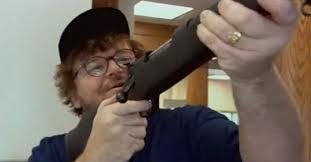Documentary filmmaker. Author. Polemicist. Michael Moore can be described with a number of terms, a few of which are more colourful depending which side of the political spectrum you sit on. To some, he’s a canary in a coal mine, firing off warnings related to the dangers of modern Western civilization. To others, he’s a fanatical blowhard who’s more concerned with sating his own ego than the veracity of his filmmaking.
Perhaps both are right…
[related_content slugs=”navigating-netflix-batman-the-movie,navigating-netflix-whats-next,navigating-netflix-lost” description=”More Navigating Netflix” position=”right”]
Regardless of where your opinion falls, it’s undeniable that his films are predominantly inflammatory in the best sense of the word and incite discussion. Bowling for Columbine is one of those films.
Moore burst on the scene with the award-winning Roger & Me, a 1989 documentary examining the negative impact of General Motors’ decision to pull out of Flint, Michigan. He continued to direct, as well as author books, that skewered American culture but it was his 2002 film that made huge waves.
Bowling for Columbine is Moore’s examination of the 1999 school shooting at Columbine High School in Colorado. The shooting remains one of the deadliest, with 13 killed and 27 injured. It was Moore’s goal to shine a light on the culture that spawned the perpetrators, that led them to this horrific act and inspired a tragedy. The title comes from the fact that the shooters participated in a bowling class that morning before beginning the attack. A mundane moment before a horrific act.
As provocative as this movie is, it has been criticized for inaccurate depictions of real events. One scene that has been particularly maligned is the bank scene near the opening of the film. The offer that Moore was exploring was a rifle that was to be given free with opening an account. The movie makes it appear easy as pie where bank employees contested that after the film’s release, saying that there were a series of checks and balances in place. Their claim was that Moore’s staff did all the legal work and paperwork earlier on to get him through the process as quickly as possible once he was in the bank. Moore contends otherwise.
Regardless of the reality of that scene, Moore’s essential point is that it is ludicrous that this offer even exists and is a signpost for the depth of gun culture in the US.
The most poignant scene in the film might be the interview with Marilyn Manson, the maligned performer who became the media/political scapegoat for the tragedy. He deftly explains why he was chosen and how effective a smoke screen it proved for other things going on at the time. In a particularly stirring moment, Moore asks Manson what he would say to the shooters if they were there with them at that moment. His response is simple. He wouldn’t say anything, he would listen to them because no one else did.
Moore is a filmmaker you either love or hate. There is rarely a mid-ground with his work as he sometimes sacrifices truth in pursuit of drama and storytelling. If you aren’t someone who shares his political outlook, then this is something that chafes as you watch.
Regardless, Bowling for Columbine is a thought-provoking piece that rips at you mind, body and soul. And, quite unfortunately, it’s still very relevant today.
—
Ian Goodwillie is a columnist for the Spectator Tribune. Follow him on Twitter at @ThePrairieGeek and on Tumblr at iangoodwillie.tumblr.com.
